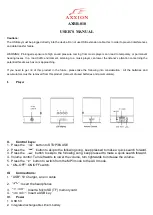
LTR-NET OVERVIEW
6-7
November 2001
Part No. 001-7240-001
voice on any repeater because the data occupies the
subaudible frequencies below the voice band.
6.6.2 HOME REPEATERS
The home repeater is used by the subscriber unit
as its primary source of incoming call and free
repeater information. When not receiving or transmit-
ting a call, it is monitoring this repeater. The home
repeater is always used to make a call if it is not busy.
In addition, if roaming mobiles searching for a new
locality cannot locate a suitable status repeater, the
home repeater is monitored (see Section 2.9.4). As
previously mentioned, up to 239 group ID codes can
be assigned on each home repeater, and the home
repeater and ID code form the “address” when making
group calls. All programmable systems which access
the same locality should be programmed with the same
home repeater (see Section 3.11.2).
6.6.3 STATUS REPEATERS
General
One repeater at each locality is designated the
status repeater. The primary function of this repeater is
to provide backup for the other repeaters at a locality
that are assigned as home repeaters. It continuously
transmits call information for all calls occurring at that
locality. The status repeater is used for voice traffic,
but is usually not assigned as a home repeater because
there would then be no home channel backup on that
repeater (see following). Roaming mobiles searching
for a new locality monitor the status repeaters. Then
after registration occurs, the home repeater is
monitored.
Backup Operation
If subscriber units were limited to only their
home repeater to receive update information and that
repeater became inoperative, all subscriber units that
were assigned to that repeater would then be unable to
place or receive calls. To prevent this from happening,
the status repeater can also be monitored for call infor-
mation.
If the signal from the home repeater is lost or falls
below a minimum threshold, the subscriber unit auto-
matically begins monitoring the locality status
repeater. If a usable signal is detected from the status
repeater, it continues to monitor that repeater. If a
message is detected that has its home repeater as the
“channel-in-use” or “free” repeater, the subscriber unit
then returns to monitoring its home repeater.
A roaming subscriber unit also monitors the
status repeater in this manner when the home repeater
signal drops below the threshold level. However, the
status repeater signal level will probably also be below
the threshold, so the subscriber unit then begins
searching for a new locality.
6.6.4 HOME CHANNEL ALIASING
The LTR-Net Home Channel Aliasing feature
increases the number of addresses available on a
locality for group calls. It does this by allowing calls
to be programmed on non-existent home repeaters.
Each home repeater can be programmed with up
1-239 group ID codes. Assume a locality has four
active repeaters and one of these is the status repeater
(which is normally not assigned as a home repeater as
described in Section 6.6.3). The number of groups that
can be programmed are then as follows:
Without Aliasing - 3 x 239 or 717 groups
With Aliasing - 20 x 239 or 4780 groups
When a call is placed on a non-existent home
repeater, the subscriber unit automatically uses the
next lower numbered active repeater. Refer to Section
2.9.7 for more information.
NOTE: Since this feature does not increase system
capacity, adding too many users may result in unsatis-
factory operation due to frequent busy conditions.
6.7 OTHER LTR-NET FEATURES
6.7.1 UNIQUE ID CODES
Each LTR-Net subscriber unit in an LTR-Net
system is assigned a unique ID (a different unique ID
can be programmed for each locality if desired). Up to
65,504 user ID codes are assignable in each locality,
and a few other codes are used for system functions.
When an LTR-Net subscriber unit places a special call,
it transmits its unique ID code along with other infor-
mation such as the call type. This data is received by
the repeater and passed on to the SSM.
















































